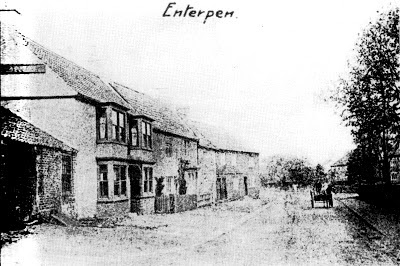From White's Directory 1840:-
RUDBY-IN-CLEVELAND is a small village on the north bank of the river Leven, 3 ½ miles W. by S. of Stokesley, and has in its township 81 souls, and 880 acres of land, mostly the property of Lord Falkland, the lord of the manor, impropriator, and patron of the
Church (All Saints,) which is a perpetual curacy valued at £185, and augmented with a parliamentary grant of £1200 in 1814. The Rev. Robt. Jph. Barlow, M.A., is the incumbent.
The parish comprises also Hutton, Middleton, East Rouncton, Scutterskelf, and Sexhow townships.
HUTTON RUDBY is an extensive village, on the southern acclivities of the picturesque dale of the river Leven, 4 miles W.S.W. of Stokesley. Its township increased its population from 707, in 1801, to 1027 souls, in 1831; and contains 1890 acres of land, including many scattered farm houses, bearing different names. Part of the village is called
Enterpen, and many of the inhabitants are employed in the manufacture of
linen cloth, ticks, drills, checks, diapers, &c., there being here a large
flax-mill, and about 250 weavers. The executors of the late Mark Barker, Esq., are lords of the manor, but a great part of the soil belongs to other proprietors, and the co-heiresses of the late Geo. Weatherill, Esq., are impropriators of the great tithes. The Wesleyan and Primitive Methodists have each a chapel here, and the former have a
Centenary School. Here is also a National School, built in 1836, and a Free School erected in 1740, and endowed with £5 a year, left by Chas. Bathurst, Esq. The poor have a yearly rent charge of 20s, left by David Simpson in 1783, and the dividends of £100 three per cent. consols, purchased with £70 left by James Young, in 1807.
MIDDLETON-UPON-LEVEN is a small township and chapelry of scattered houses, in the picturesque dale of the river Leven, 4 ½ miles S.E of Yarm. It contains 89 souls, and 850 acres of land, mostly the property of Colonel Wyndham and Lord Falkland, the former of whom is lord of the manor, and the latter impropriator of the tithes. The
Chapel of Ease is a perpetual curacy united with Rudby, and augmented with £1000 of Q.A.B., from 1740 to 1824.
Directory:- Jas Coulson, corn miller; Walton Fawell, vict.,
Chequers; and Hy Colbeck, Bartw. Gouldsbrough, Thos Legg, Thomas Righton, Wm Sleigh, Wm Smith, and John Tweddale,
farmers.
ROUNCTON (EAST,) 7 miles S. of Yarm, is a small village on a lofty eminence, and has in its township 127 souls, and 1600 acres of land, belonging to various families. The
Grange is the seat and property of John Wailes, Esq. The
Chapel of Ease is a perpetual curacy annexed to Rudby, and augmented with £1000 of Q.A.B., from 1747 to 1817.
Directory:- Wm Carnagie, gardener; Mrs Ann Granston.; Wm Hildreth, tailor; Wm Lilburn, vict. and smith, Black Swan,
Trenholme Bar; John Wailes, Esq.; Thos Wailes, shoemkr; John Atkinson, Ann Kilvington and Son, and Rd Scarth,
farmers and owners; and Jph Fidler, John Hall, Rt Kendall, and David Smith,
farmers.
SCUTTERSKELF, or SKUTTERSKELF, 3 miles W.S.W. of Stokesley, is a small township containing only 38 souls, and 880 acres of land, all the property of the
Rt. Hon. Lucius Carey, Viscount Falkland, and Baron Carey, a Scotch peer, whose seat is
Scutterskelf Hall, a handsome Grecian mansion, erected in 1831, in the sylvan dale of the river Leven, near Leven Grove, which was the seat of the late Lady Amherst, but was taken down a few years ago. The
farmers are John Dodsworth, John Redhead, and John Wrighton; Pp. Hibberd, gamekeeper; and Roderic McRea, gardener.
SEXHOW township, on the south side of the vale of Leven, 4 miles S.W. by W. of Stokesley, has only 35 souls, and 540 acres of land, all the property of Sir Wm. Foulis, but formerly belonging to the Laytons, whose ancient hall is now occupied by two
farmers, Geo. Redhead and Thos. Chapman. The other farmers are John Duck, Rt. Newsam, and Stephen York.











-.jpg)
















